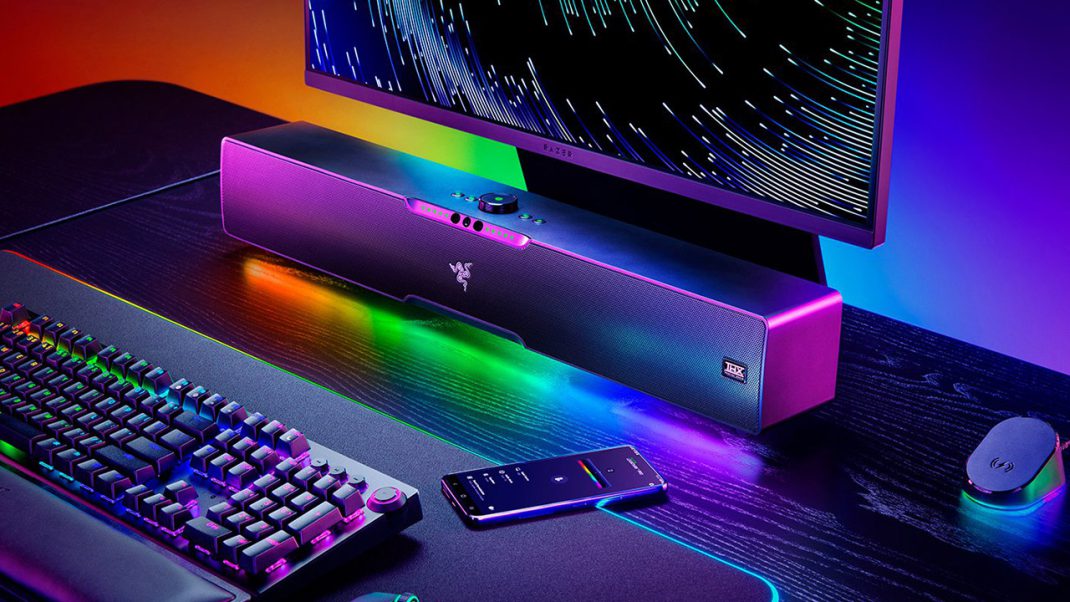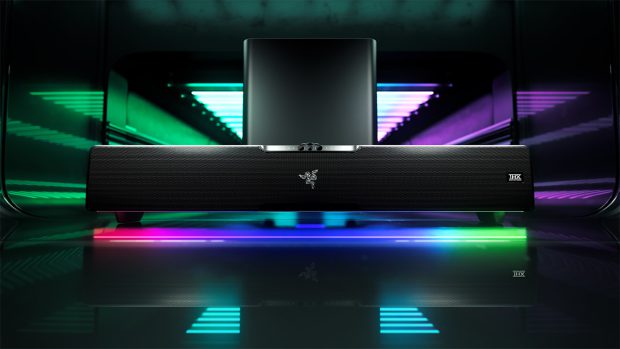When I first read the press release for Razer’s new Leviathan V2 Pro soundbar, I was intrigued, to say the least. The Leviathan V2 Pro features an infrared camera that tracks the position of your head and performs “adaptive beamforming.” This means that it changes how it projects sound to give you the best soundscape no matter where you are in relation to the front of the soundbar. It promises to be a virtual headset, partly due to its THX Spatial Audio (an impressive audio feature capable of excellent virtual surround sound). So many thoughts raced through my brain… Does adaptive beamforming really work? What happens to the images snapped by the infrared camera? What kind of software will be needed to tune the soundscape? For these answers and more – read on, my fellow gamer!
The Razer Leviathan V2 Pro is a reasonably robust soundbar by all accounts. Measuring almost twenty-four inches across, its stealthy black housing contains five 2-inch, full-range drivers and all the head-tracking tech. It is adorned with a mirrored Razer logo across its front-facing grill and has full Chroma RGB along its bottom perimeter. It is connected by a 3.5 mm cable to a separate unit that houses a downward-firing 5.25-inch subwoofer driver. This speaker configuration is a departure from its siblings in the Leviathan lineup. It features more capable but numerically one less driver than the Leviathan V2 standard edition. Its subwoofer driver is also .25 inches smaller in diameter.
Setting up the Razer Leviathan V2 Pro was very easy. After getting the soundbar and subwoofer unit connected and plugged into my PC via USB cable, I started my desktop machine. Razer Synapse updated, and the device was ready to go. It should be noted that a firmware update was available for the Leviathan V2 Pro and that needed to be installed outside of Razer Synapse. I would love to see these firmware updates handled within Synapse at some point in the future.
Configuring the soundbar is best done within the Razer Synapse application. In Synapse, you’ll be able to control the soundbar’s EQ and the type of audio mode the soundbar is in. The Razer Leviathan V2 Pro can function in four different modes: Stereo, THX Spatial Audio Virtual Headset, THX Spatial Audio Virtual Speakers, and Room Filling. Stereo mode projects native sound without any virtual processing. The THX Spatial Audio Virtual Headset function is where the soundbar fools your ears into having a headset-like experience while not wearing one. The results are outstanding, and the included THX Spatial Audio video within Synapse will let you gauge for yourself. It does sound like a more intimate headset experience. THX Spatial Audio Virtual Speakers is a more traditional surround sound experience where the Leviathan V2 Pro pretends to be a 5.1 or 7.1 virtual surround sound system. Much like the virtual headset mode, this is excellent and a joy to play games or listen to music with. The last method, Room Filling, projects sound to a broad audience without virtual surround capabilities. This last mode is excellent for when you’re using the soundbar to play music at a party or for your enjoyment while not in front of it. Switching between these modes can also be accomplished by pressing the “3D” button on the Leviathan V2 Pro itself.
Also, along the top of the Leviathan V2 Pro, you’ll find a volume dial with a power button, equalizer mode button, output button, and Chroma effects button. The equalizer button cycles the soundbar through various EQ modes (game, music, flat, etc.). In contrast, the output button switches the Leviathan V2 Pro between standard, Bluetooth, and headset modes (a headset can be connected to the 3.5mm port on the back of the soundbar). There are green LED indicator dots next to the front-facing IR camera, which denotes your mode when pressing the various buttons. It’s a simple notification system but very effective.
Regarding privacy, the Razer Leviathan V2 Pro has a hardware chip that’s sole purpose is to dispose of the images almost immediately after they are processed. This means you can rest easy knowing someone can’t hack into your soundbar to spy on you.
I played many games using the Leviathan V2 Pro as my sound output – both with and without the virtual headset mode engaged. From the orchestral score of Hogwarts Legacy to the rapport of an M4 firing in Call of Duty, the Razer Leviathan V2 Pro was more than up to the task. The Razer Leviathan V2 Pro is available now for $399.99. It is not cheap in any sense of the word, including the measure of quality. It’s a high-end gaming soundbar that is well worth your hard-earned money. Thankfully, if you still need a soundbar, but the Leviathan V2 Pro is out of your price range, Razer does offer the other Leviathan soundbars in the range for a less expensive price point. Check out Razer’s official website for information on the Leviathan V2 Pro and all its other peripherals.






